Temperature Snapshot:
• Northeast: Warmer to much warmer than normal
• Mid-Atlantic: Warmer to much warmer than normal
• Southeast: Warmer to much warmer than normal
• Ohio Valley: Warmer than normal
• Northern Plains: Warmer than normal
• Central Plains: Warmer than normal
• Southern Plains: Warmer to much warmer than normal
• Pacific Northwest: Somewhat cooler than normal to near normal
• California/Southwest: Near normal to somewhat warmer than normal
Precipitation Snapshot:
• Northeast: Near normal
• Mid-Atlantic: Near normal (below normal in the lower Mid-Atlantic region)
• Southeast: Below normal
• Ohio Valley: Near normal to above normal
• Northern Plains: Near normal
• Central Plains: Near normal
• Southern Plains: Below normal to near normal
• Pacific Northwest: Above to much above normal
• California/Southwest: Below normal to near normal
Snowfall Estimates for Select Cities:
Baltimore: 12”-17”
Boston: 25”-35”
Burlington: 75”-85”
Chicago: 40”-50”
New York City: 10”-20”
Philadelphia: 10”-20”
Pittsburgh: 25”-35”
Providence: 20”-30”
Richmond: <6”
St. Louis: 15”-25”
Washington, DC: 7”-12”
ANALYSIS:
ENSO Forecast:
The overwhelming share of the CFS’s ensemble members and the ECMWF’s latest ENSO forecast suggest that a moderate La Niña is likely to predominate through much of the upcoming winter.
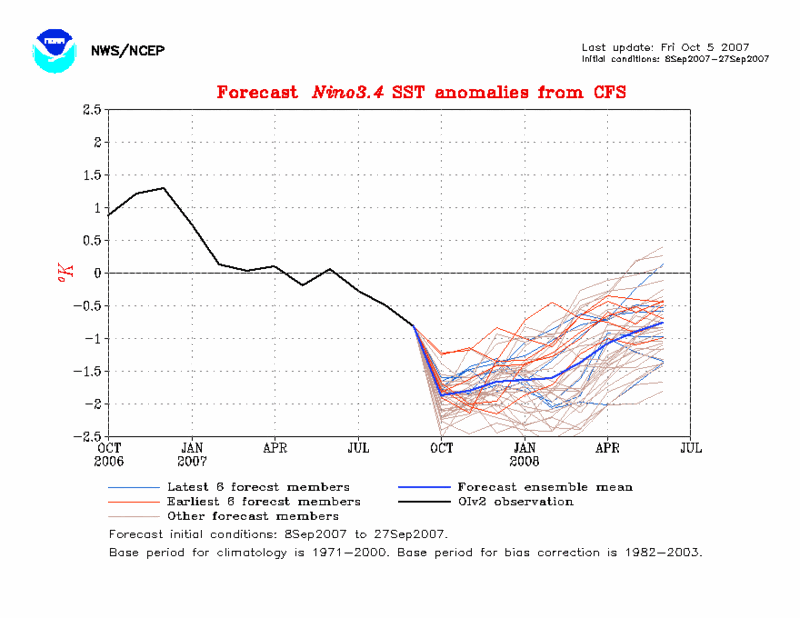
Most early model guidance had pointed to a weak to borderline moderate La Niña. Given the model trends and recent evolution of the present ENSO region anomalies, I lean toward the idea of a moderate La Niña.
The August-September Multivariate ENSO Index (MEI) declined to -1.109. The fall of 0.675 from the July-August period was the second sharpest for August-September since recordkeeping began in 1950. In 5/6 (83%) cases in which the August-September MEI fell by 0.300 or more from the preceding period, the MEI for November-December through February-March averaged lower than that for the August-September timeframe. In the single exception (2001-02), it averaged .152 higher. Therefore, I believe the MEI will likely average -0.75 or below for the November-December 2007 through February-March 2008 timeframe. The composite temperature anomalies for the December-February timeframe for such situations is as follows:
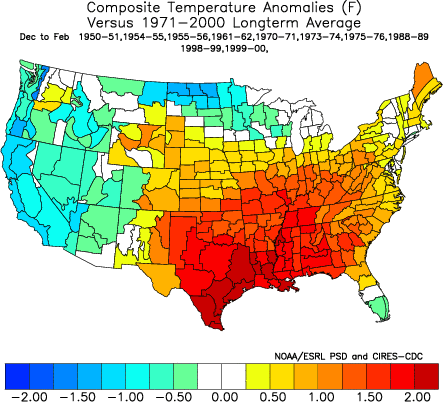
It should be noted that applying only winters beginning in 1979-80 that met such criteria yielded a much smaller area of cool anomalies and a much more expansive area of warm anomalies, including over the Northern Plains. This would fit well with the observed trend toward warming winters in recent decades where the northern latitudes have experienced among the largest extent of warming.
ENSO: Extreme Situations:
2007 is only the 4th year on record in which the ENSO Region 1+2 temperature fell below 19.5°C at the same time when the ENSO Region 3.0 reading was below 24.5°C. The other years in which that occurred were 1996, 1999, and 2001.
The composite anomalies for the winters (December-February) that followed such situations were generally warmer than normal nationwide.
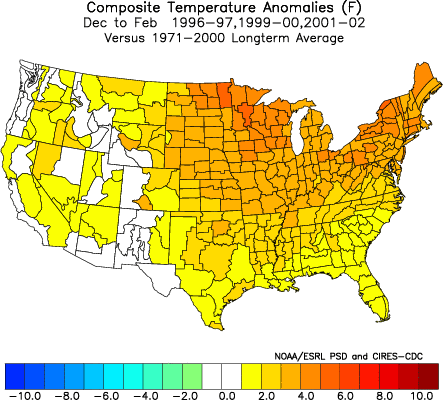
In general the areas that were most likely to see warmer than normal readings were the Northeast (3/3 cases) and the Mid-Atlantic (3/3 cases). With the single exception of the Northern Plains and part of the Central Plains States, all other areas generally saw near normal to above normal readings. In one case, the Northern Plains and a portion of the Central Plains region saw a colder than normal winter. However, considering that the past ten years have seen this region average much warmer than normal in terms of the 10-year anomaly relative to the 1971-2000 base, odds are against that region witnessing a colder than normal winter.
Models:
The CFS is currently indicating a warmer than normal winter in the East and generally colder than normal in the West (particularly the Pacific Northwest and western Canada).
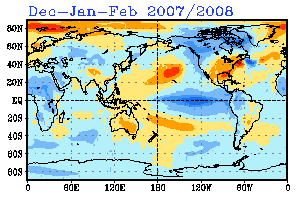
The ECMWF’s seasonal idea is similar, though with more widespread warmth. Such an outcome is well-supported by past precedent with respect to sea surface temperature anomalies (SSTAs).
Sea Surface Temperature Anomalies:
Both the latest December-February SSTA forecasts from the CFS and IRI highlight the following key anomalies:
• Cool SSTAs off the West Coast
• A substantial area of warmth off the Atlantic Coast
• General warmer than normal SSTAs in the Bay of Baffin/Davis Straits area
IRI SSTA Forecast (December-February):
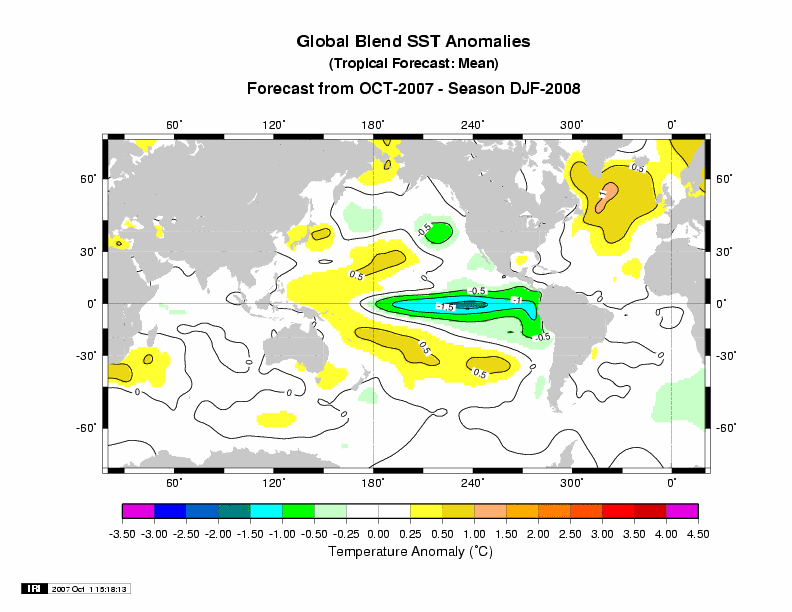
Such a situation has generally featured a winter with warmth in the East and colder than normal readings in the West. In all cases, the East was generally warmer than normal. The composite for such winters is below:
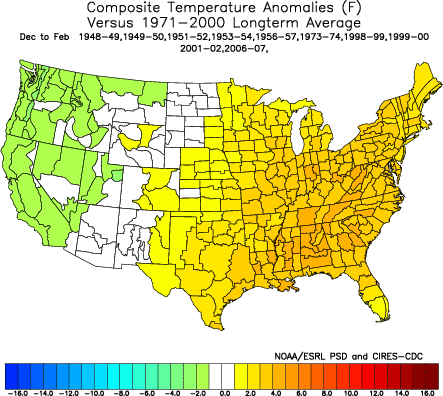
That composite idea matches very well with the latest CFS model guidance. Moreover, if one takes all winters subsequent to 1979-80 with SSTAs similar to what is forecast for December-February of 2007-08, the cool anomalies give way to near normal readings, while the warm anomalies persist. That fits well with the observed warming that has been ongoing in recent decades.
Two of the seasons in question coincided with the extreme ENSO conditions noted earlier in this discussion: 1999-00 and 2001-02. One of those seasons (2001-02) also saw a substantial drop in the MEI in the August-September timeframe as occurred this year.
Local Temperature/Precipitation Profile:
Recent temperature and precipitation patterns have been consistent with a profile that typically witnessed much below normal snowfall in the East, especially in the Northeast. Average snowfall for such seasons came to 10.5” in Baltimore, 23.5” in Boston, 13.0” in New York City, and 9.6” in Washington, DC (DCA). Such snowfall is reasonably consistent with moderate/strong La Niña-negative PDO winters.
Anecdote:
There is an old saying that “Should in mud and slush the first snow fall, look for a mild winter, and a muddy withal.” Given the warmth that is likely to predominate this month with a cool period in the middle before renewed warmth returns, it is entirely possible that the season’s first snow in parts of the United States could fall on the proverbial “mud and slush.” If typical moderate La Niña conditions prevail, that anecdote could come true with a vengeance. Time will tell.
 The posts in this forum are NOT official forecast and should not be used as such. They are just the opinion of the poster and may or may not be backed by sound meteorological data. They are NOT endorsed by any professional institution or
The posts in this forum are NOT official forecast and should not be used as such. They are just the opinion of the poster and may or may not be backed by sound meteorological data. They are NOT endorsed by any professional institution or 








